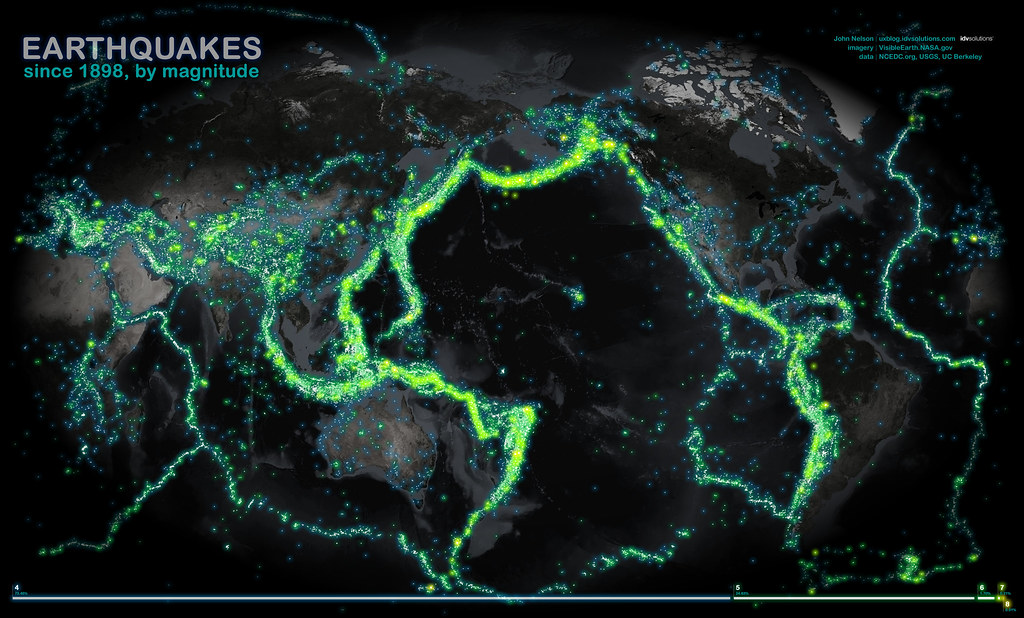Middle School | Daily Do
Why Do Earthquakes Occur Where They Do?

Earth & Space Science Is Lesson Plan Middle School Grades 6-8
Sensemaking Checklist




Introduction
Earthquakes are exciting and intriguing events to most students, but many do not have a deep understanding of why they occur in the places they do. In today’s Daily Do, Why do earthquakes occur where they do?, students analyze and interpret data, and use the thinking tools of patterns and cause and effect, to begin building understanding of how earthquake locations provide evidence of the flow of energy and cycling of matter within the Earth.
Experience the Phenomena
The United States Geological Society (USGS) Earthquake Hazards webpage is an excellent source of current and historic earthquake data as well as information about selected significant earthquakes. The map above shows a day in September 2020, when 35 earthquakes (greater than magnitude 2.5) occurred. You might share the above earthquake map with students or retrieve a current map to share. Make sure the map displays enough earthquake data for students to be able to recognize a pattern (or emerging pattern).
Tell students you have an intriguing phenomenon to share. After hearing a news story about an earthquake that occurred today (or on a previous day), you decided to visit the USGS’ website to view the location and were surprised to find it was only one of 35 earthquakes that occurred that day! (Make sure to adjust the number if using data from a different day.) Share the map from the USGS’ Latest Earthquake webpage with students. Point to a few circles of different sizes and ask, “What do you think the size of the circle represents?” (size of earthquakes) Tell students the color of the dot indicates how long ago the earthquake occurred. (Note: If using a live map, click on the key in the upper right-hand corner to reveal the explanation for dot size and color.) Ask students to create a Notice and Wonder t-chart in their notebooks. Give students independent thinking time (Alone Zone) to record observations in the Notice column and to note any questions they have under Wonder. Then, have students share what they notice and wonder in small groups and note anything they have in common with their group members.
As students compare their observations, listen to the prior knowledge and misconceptions (preconceptions) they share with each other. At this point it is not important to correct preconceptions; consider asking probing questions to elicit what prior knowledge or experience students are basing their ideas/explanation on. Students might offer “plate boundaries” or “plate tectonics” to explain the pattern of earthquakes. This is OK. Say to these students, “I wonder how we might find evidence to support your claim.”
Next, provide students with a map displaying locations of earthquakes that occurred over the past 30 days. Ask students to independently identify patterns in the data presented in the 30-day map and patterns they observe between the two data sets (30-day map and 1-day map); instruct them to record the patterns they notice in the Notice column of their t-chart. Encourage students to add new questions to the Wonder column. This is a great opportunity to challenge students to help each other transform closed-ended questions to open-ended questions utilizing the Question Formulation Technique (see supporting Question Formulation Technique Google slides) Giant whiteboards or Whiteboard.fi could be utilized to make this process more collaborative.
Ask students to share their open-ended questions with the class. You might ask students to use the thumbs up/thumbs down strategy to show if they agree or disagree the question is open-ended. If students indicate they disagree, you might ask how they would change the question to make it open ended. (You might ask students to write the revised question on their whiteboard and show them at the same time.) Make a class record of their questions; you might use check marks to indicate how many students ask the same or similar question. Students’ questions will likely include:
- What causes earthquakes?
- Why are earthquakes different sizes?
- How can they happen in water? (Are most earthquakes in the ocean?)
- Why do earthquakes happen in the middle of oceans?
- Why do earthquakes happen on coasts?
- How many earthquakes happen in a year?
- Why are the earthquakes in lines?

Introduce one more set of data to students, 100 Years of Earthquake Data. You can retrieve a larger image of the 100 Years of Earthquake Data map from flikr. Again, give students independent thinking time to identify and record patterns in the data presented in the 100-year map. Ask students to record new questions they have, making sure they are open-ended. Move students back into small groups to share their observations and new questions. Then, ask students to choose one question to share with the class; this can be their own question or a question someone else shared.
Create a Driving Question Board
Create a space in the classroom or digital space (Jamboard works well) for students to post their questions (Driving Question Board). Explain to students we are going to share and organize our question. Tell students to carefully listen to the question being read aloud, and then raise their hand if they have a related question. Ask a student to volunteer to read and post the first question, and then call on a student with their hand raised to share the next question. The next student reads their question and places it on the board near the previous question, and then calls on someone with their hand raised. Continue in this way until all the related questions are shared, and then start the process again by asking a student to volunteer to read and post their question.
Students’ questions will likely include:
- What causes earthquakes?
- Are some earthquakes caused by volcanoes? (Hawaii)
- Why are earthquakes different sizes? (How do you measure the size of an earthquake?)
- Why do some earthquakes happen right in the middle of oceans?
- Why do earthquakes form lines?
- Why do earthquakes happen on some but not all the coasts?
- Why don’t all earthquakes happen on plate boundaries?
- What’s a tsunami?
- How many earthquakes happen in a year?
- Can an earthquake happen here?
- Can earthquakes be predicted?
Once all questions have been shared, ask students to review the driving question board to see if they can come up with any broader categories or overarching questions for each group of student questions. For example, one category might be about causes of earthquakes and one about location of earthquakes. Ask students to consider how we might investigate to find answers to these questions.


